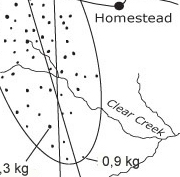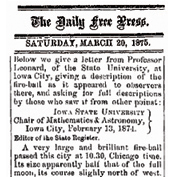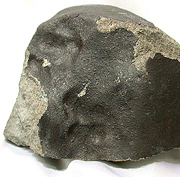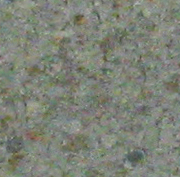Official Name:
Homestead gets its name from the town near which the meteorite shower fell. Amana and Iowa County are synonyms that are sometimes used instead. These synonyms refer respectively to another town near the fall site and to the wider area affected.
Location:
West of the railway town of Homestead, Iowa, USA.
Fall or Find:
Fall. The meteoroid's passage through the atmosphere was observed by many witnesses.
Date:
12 February 1875, 10:15 p.m., local time.
Mass Recovered:
226.8 kilograms of the Homestead meteorite were recovered.
Number of Fragments:
About a hundred stones fell that night. The heaviest fragment weighed 33.6 kilograms.
Strewn field:
The strewn field was 10 kilometres long and covered an area of 45 square kilometres between the communities of Amana and Boltonville. The heaviest fragments fell at the front of the ellipse, while the others were distributed according to their mass.

Enlargement
The fragments of the Homestead meteorite were perfectly distributed according to their mass. |
|

Enlargement
Article from the Daily Free Press inviting citizens to report their observations of the Homestead fireball. |
|
Crater:
Most of the fragments were small and bounced off the snowy ground without forming any notable craters.
Circumstances:
On a cold, clear winter night, witnesses observed a brilliant yellow ball of fire travelling northward. The fireball was brighter than the full moon-it hurt to look at it with the naked eye! Explosions resembling the rumble of thunder accompanied the luminous phenomenon. The meteoroid broke apart a first time at an altitude of three kilometres, after which it fragmented two more times. The passage of the fireball frightened many citizens.
The largest fragment was discovered in the spring of 1875 by a man named Henry Mass. He used it to hold down the lid of his sauerkraut barrel! A company later claimed the fragment because it had been found on its property.
History:
In more than one respect, Homestead was a real first in the history of meteorites. For example, several discoverers sold their finds-it was after this shower that selling meteorites became more common in the United States. In addition, citizens were invited by the newspapers to report their observations of the fireball.
Type:
Stony meteorite
Class:
Ordinary chondrite
Group:
L5

Enlargement
2.6-kilogram fragment of the Homestead chondrite.© R.A. Langheinrich Meteorite Collection. |
|

Enlargement
Cut of the Homestead meteorite revealing its various constituents. |
|
Composition:
Homestead is covered by a very fine fusion crust that is dull black. Its pale grey interior is flecked with metal particles and chondrules. The chondrules are difficult to make out. Homestead contains little iron-it accounts for only 22.2% of the meteorite's volume.
Scientific contribution:
Scientists consider Homestead to be the finest textbook example of an elliptical distribution of fragments from a meteorite shower.
Comments:
Three of the biggest meteorite showers in America fell in Iowa between 1875 and 1890. Homestead was the first of them-followed by the Estherville (1879) and Forest City (1890) showers.
Part of the Planétarium's collection:
Yes